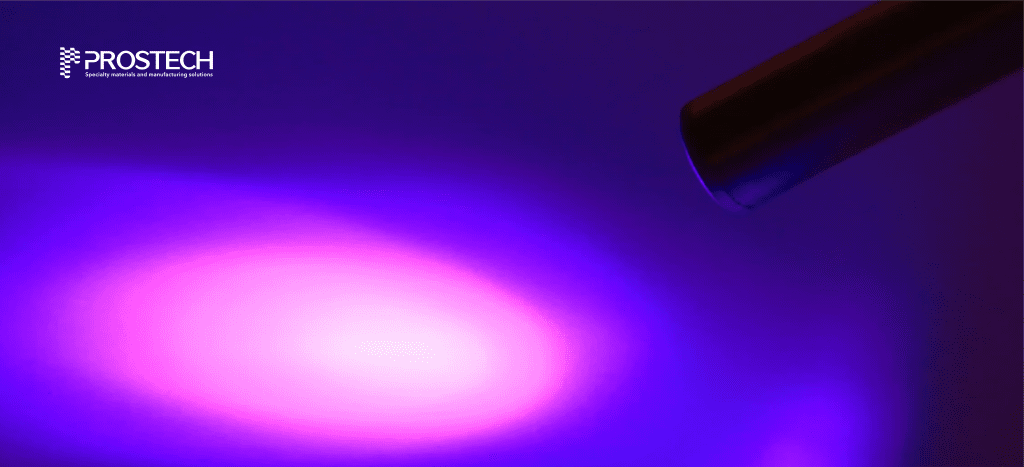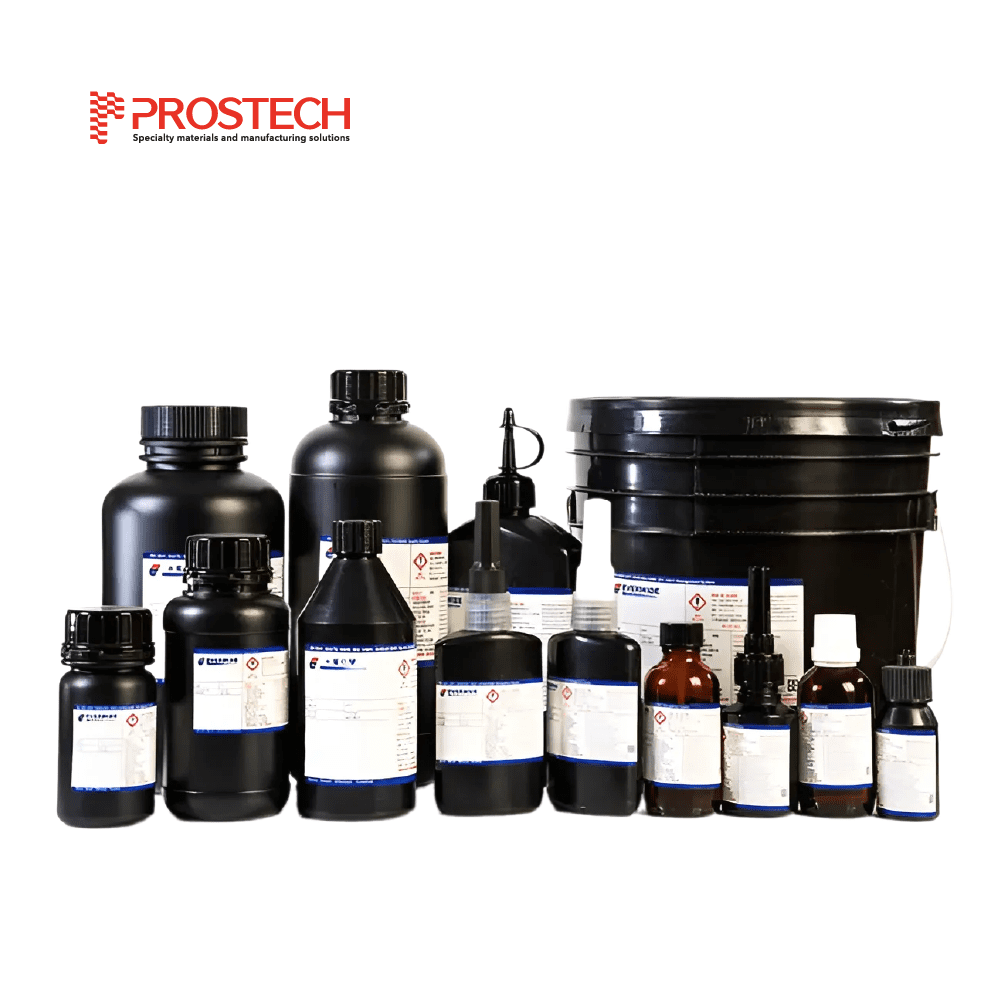UV adhesive is a single-component adhesive known for its extremely fast curing capability and is typically associated with the light cure mechanism. Understanding the specific curing mechanism of UV adhesive and the factors that can affect its curing process will help you apply this adhesive most effectively, resulting in high productivity.
1. Curing mechanism of UV adhesive
UV adhesive is composed of monomers, oligomers, and photoinitiators. Monomers and oligomers form the structure of the adhesive after curing, while photoinitiators initiate the polymerization reaction.
In order to know more about the key features of UV adhesive, you can refer to this article: UV Adhesive and Its Characteristics
When exposed to UV light with appropriate wavelengths and intensities, photoinitiators absorb energy from the UV light, leading to electronic state changes and initiating reactions. UV light typically ranges from approximately 365 nm to 405 nm. The absorbed energy is converted to change their electronic state, elevating the molecules to an excited state (higher energy state). In this state, they can emit light (fluorescence) or participate in other chemical reactions.
A common reaction is the cleavage of isomer bonds, where photoinitiators containing carbonyl groups are used to generate free radicals. These free radicals can initiate reactions directly or by hydrogen atom abstraction from compounds.
Many molecules, when stimulated by light, undergo reactions to produce acids or bases capable of initiating ion-polymerization reactions. Some common photoinitiators include phosphine oxide, ketone, onium salts, and benzoin esters, acetophenone, oxime, etc.
For example:
|
Phosphine Oxide |
Ketone |
|
|
|
|
|
Light absorption initiates a series of physical transformations of photoinitiators, ultimately leading to chemical reactions. The reaction process proceeds as follows:
|
Reaction |
Detail |
|
Initiation of Reaction |
After the photoinitiator decomposes into free radicals, these radicals act on monomers and oligomers, activating the polymerization reaction chain. These free radicals have an unpaired electron, making them highly reactive and able to participate in reactions with monomers or oligomers. |
|
Propagation of Reaction |
The free radicals propagate and form new chemical bonds with other monomer or oligomer units, creating new chains or polymer networks. This propagation process continues until there are no longer enough free radicals to create new chemical bonds. Monomers and oligomers bond together through cross-links, forming a strong polymer network. This process transforms the adhesive from a liquid to a solid state. |
|
Termination of Reaction |
When UV exposure stops, no new free radicals are generated. However, previously formed free radicals continue to be active until they find a way to stabilize. These free radicals can stabilize by combining with other free radicals or reacting with other molecules in the environment, thereby terminating their reaction chains. When all monomers and oligomers have participated in the polymer network and no active free radicals remain, the UV adhesive is considered fully cured. At this point, the adhesive exhibits high mechanical strength and strong bonding capabilities. |

Prostech, with many years of providing specialty material for manufacturing, we can advise you comprehensive solutions of applying UV adhesive process, help you to improve your production efficiency, quality, and long-term benefits.
2. Factors affecting curing-ability of UV adhesive
The curing time of UV adhesive can be influenced by several factors:
- UV Light Intensity: It refers to the amount of light energy emitted by a light source or received by a surface, within a specific time unit. When light shines, each beam (called a photon) can generate one or more active chemical particles. The efficiency of this process, meaning how many active particles each photon generates on average, is referred to as “quantum yield.”
Three factors affect this process: (1) the ability of a substance to absorb light referred to as the absorption coefficient), (2) the amount of reacting substance present in the environment (reactant concentration), and (3) the strength of the incident light (light intensity). As light penetrates deeper into a sample, it weakens, reducing the likelihood of triggering the reaction. The amount of light absorbed by the sample depends not only on the light intensity but also on the duration of light exposure. The total absorbed light is calculated as a “dose,” the result of the absorbed light intensity multiplied by the exposure time.

This means that both factors—light intensity and exposure time—are important in determining the speed and efficiency of the reaction. The strength of the UV light source is crucial. Point source lamps provide a concentrated UV beam that can cure adhesives very quickly, while flood lamps and LED lamps vary in intensity, and UV fluorescent lamps provide a cost-effective but slower solution.
- The distance between the light source and the substrate: The distance between the UV light source and the substrate significantly affects the curing time of UV adhesive. This is due to the inverse square law, which states that light intensity decreases inversely with the square of the distance from the light source. When the distance doubles, the light intensity decreases to about 25% of the original intensity.

To further explain the impact of the distance between the UV lamp and the substrate on the curing time of the adhesive, we can consider this law describing the relationship between light intensity and the distance from the light source. Specifically, light intensity decreases inversely with the square of the distance from the light source. This can be expressed by the following formula:

(I) is the light intensity at a point (W/m²),
(P) is the total luminous power of the light source (W),
(r) is the distance from the light source to that point (m).
According to this formula, if the distance between the UV lamp and the substrate doubles (r increases by 2 times), the light intensity (I) will decrease to 1/4 of the original.

- Thickness of the adhesive: The permeability of UV rays decreases as they pass through layers of material. When the adhesive layer is thicker, the amount of UV rays reaching the bottom surface of the adhesive layer will be less, potentially resulting in only partial curing on the surface. This prevents UV light from reaching the adhesive layer below, thus requiring a longer exposure time to ensure that the entire adhesive layer is cured evenly and completely. This helps avoid improperly cured adhesive, leading to poor durability or failure to meet technical requirements. This is an important principle in the use of UV adhesives.

Prostech offers a wide range of UV adhesive products which can deliver clearer results, and are suitable for each industrial manufacture. Contact us to receive valuable information and consultation from our qualified experts.
- Photoinitiator: To achieve optimal curing efficiency, the spectral output of the UV lamp must match the wavelength at which the photoinitiator absorbs well, typically in the range of 365-405 nm. If the spectral output of the lamp does not match the photoinitiator, the curing process will be ineffective, resulting in improperly cured adhesive or longer curing times. Therefore, selecting the appropriate photoinitiator that matches the UV lamp is crucial to ensure the quality of the final product. Typically, suppliers provide information on the optimal wavelength range for UV adhesive curing in the Technical Data Sheet (TDS) of the product. This helps users choose the appropriate UV lamp to ensure an efficient curing process. Therefore, users should adhere to the technical specifications outlined in the TDS to achieve the desired curing results.
- Other factors:
- Temperature and humidity: These environmental factors can affect the photopolymerization process and the performance of UV light-curable adhesives.
- Oxygen inhibition: The presence of oxygen can inhibit the curing process, affecting the final properties of the adhesive.
- Substrate type: The ability of the substrate to reflect or absorb UV light can affect whether the light reaches the adhesive layer effectively.
- Type and lifespan of lamps: Different types of UV lamps peak at different wavelengths, so they should match the optimal curing wavelength of the UV adhesive. Over time, lamps may lose intensity in the UV spectrum, resulting in slow or incomplete curing of the adhesive.
3. Conclusion
In conclusion, the photochemical process initiated by UV light exposure offers numerous advantages, including rapid curing, precise control over bonding, and solvent-free application. Factors such as UV light intensity, distance from the light source, adhesive thickness, choice of photoinitiator, and environmental conditions play crucial roles in determining the curing efficiency and final bond strength of UV adhesives.
By grasping the intricate details of UV adhesive curing, manufacturers and engineers can optimize their processes, enhance product quality, and achieve superior performance in bonding applications. Incorporating UV adhesive into manufacturing processes offers a sustainable, cost-effective solution with minimal environmental impact. As such, embracing UV adhesive technology represents a forward-thinking approach towards achieving robust, high-performance bonding solutions for modern industrial applications.
PROSTECH is a reputable partner, providing a wide range of UV products suitable for various applications across different manufacturing industries.









